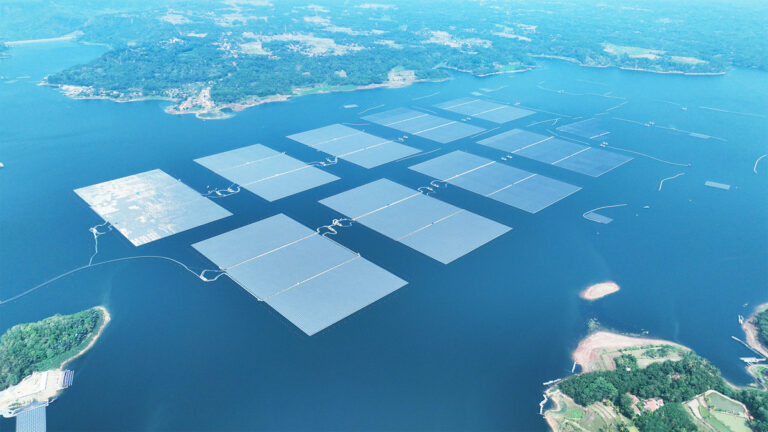Home Marine Energy Floating solar poised to play ‘critical role’ in land-lacking Southeast Asia
With a lack of suitable sites for onshore solar farms intensifying the need for innovative solutions, floating solar is expected to play a key role in Southeast Asia’s solar expansion, according to Rystad Energy research.

Solar photovoltaic (PV) capacity additions are poised to be a central pillar of Southeast Asia’s energy future, with floating installations primed to play a critical role, overcoming limited land availability and presenting an opportunity to increase renewable energy generation without deforestation, Rystad Energy’s report writes.
Mirroring the broader Asian region’s dominance of the global floating PV (FPV) market, Rystad Energy research shows that Southeast Asia will account for 10% of the region’s total solar capacity by 2030, encompassing ground-mounted, rooftop, and FPV installations, with the Philippines, Indonesia and Thailand well-positioned to be at the forefront.
However, addressing land rights is a pivotal challenge for solar developers in Southeast Asia due to the predominant use of available land for agricultural purposes and the region grapples with a scarcity of suitable sites for solar farms. Rystad Energy notes that FPVs have emerged as a viable option, leveraging bodies of water adjacent to agricultural areas – an approach that circumvents land access tensions and presents a potential blueprint for other countries having similar issues.
“FPVs have emerged as a game-changer for Southeast Asia, catalyzing the region’s push towards clean energy by maximizing its abundant solar resources and overcoming limited land availability. Their modular design allows for integration with existing hydropower dams and unlocks tremendous opportunities for hydropower-rich nations like Laos, Thailand and Indonesia,” said Jun Yee Chew, Head of Asia renewables and power research at Rystad Energy.
“Additionally, with land rights a major deterrent facing solar developers in Southeast Asia, as much of the land is used for agriculture, FPVs provide a solution for the coexistence of solar farms and agriculture.”
Operational FPV projects in Southeast Asia currently amount to around 500 MW combined, and, according to Rystad Energy’s data, an anticipated 300 MW of FPV capacity is expected to be added across Southeast Asia early this year alone.
Currently, nine of the world’s top 10 FPV projects by size are in China, with the only exception being the Cirata FPV project in West Java, Indonesia, which was commissioned in November 2023. Owned by Indonesia’s state-owned utility company PLN and Abu Dhabi Future Energy Company – Masdar, the Cirata FPV project is the largest of its kind in Southeast Asia, surpassing others in mainland China and Taiwan.
Posted: 2 months ago
Rystad Energy explains that in Thailand companies are contracting FPVs and procuring electricity through private power purchase agreements (PPAs), which is a strategy similar to rooftop solar leasing with individuals or businesses leasing their rooftop space to solar companies, and by maximizing this approach to land utilization, Southeast Asia can not only sidestep the intricate web of land rights issues but also promote the sustainable integration of solar energy.
As an archipelago, the Philippines has many large inland lakes that are suitable for FPV, such as Laguna Lake, where there are plans for nearly 3 GWac of capacity, the report states.
Philippines-based ACEN, set to become the top FPV developer in Southeast Asia by the end of this decade, is working to commission a 1 GW project on Laguna Lake, along with a 200 MW project in the province of Rizal. The company currently has the largest and fastest-growing solar PV portfolio in the region, which will surpass 3 GW by the time the two FPV projects come online. Filipino solar company SunAsia and Singapore-headquartered Blueleaf Energy will also build a gigawatt-scale FPV in Laguna Lake, along with projects in other locations in the Philippines.
Indonesia has a 1.8 GW FPV project on the horizon at the Duriangkang reservoir in Batam, which is being led by Spanish EDP Renewables. Rystad Energy expects the development of FPV projects in Indonesia to accelerate given the temporary reduction in local content requirements for solar PV until 2025, when the nation’s first PV manufacturing plant is expected to come online.
The first-of-its-kind assessment conducted by National Renewable Energy Laboratory (NREL) researchers concurs with Rystad Energy’s findings. Namely, an NREL report published in the summer of 2023 stated that FPV has the potential to help countries across Southeast Asia reach their ambitious renewable energy generation goals.
“FPV is an option that can allow many of these countries to take advantage of high-quality solar resources to combat challenges such as land availability or rugged geographies that can make siting traditional renewable energy sources difficult,” said Sika Gadzanku, the NREL energy technology and policy researcher who led the development of this analysis. “They also offer resilience opportunities in regions that use a lot of hydropower but are facing droughts and significant changes in rainfall patterns.”
>>> Read full article>>>
Copyright for syndicated content belongs to the linked Source : OffshoreEnergy – https://www.offshore-energy.biz/floating-solar-poised-to-play-critical-role-in-land-lacking-southeast-asia/